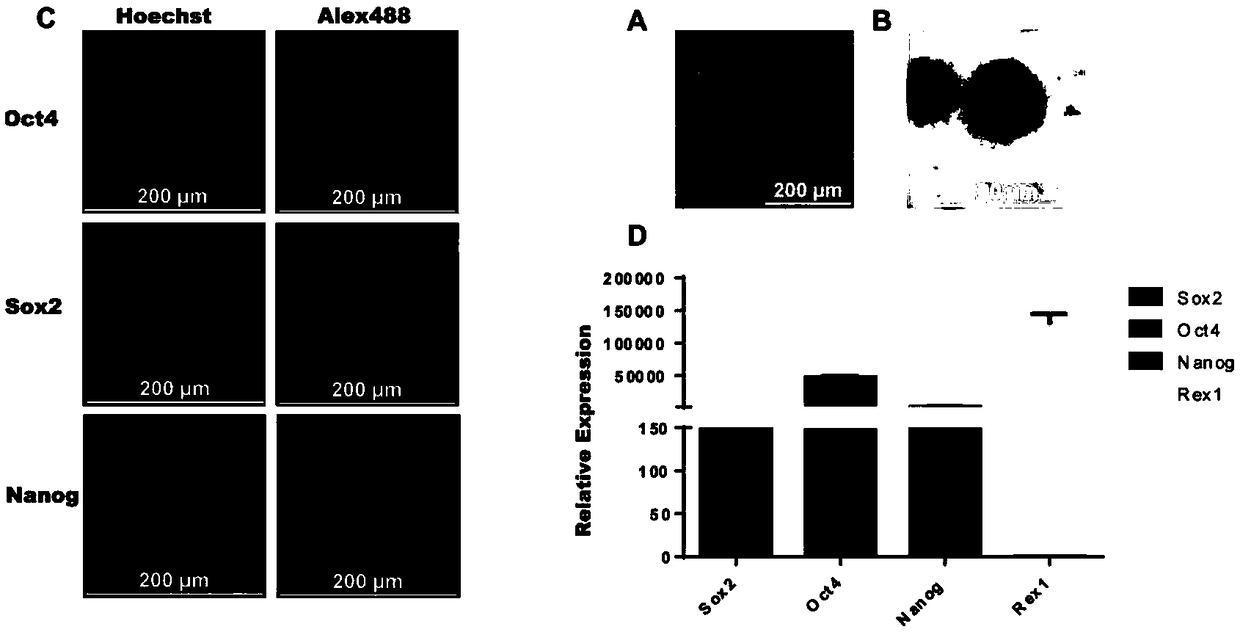Unicellular fusion method for pig and mouse cells
A fusion method and single-cell technology, applied in the field of cell engineering, can solve the problem of low fusion efficiency of heterogeneous cells and achieve the effect of improving the efficiency of cell fusion
- Summary
- Abstract
- Description
- Claims
- Application Information
AI Technical Summary
Problems solved by technology
Method used
Image
Examples
Embodiment 1
[0076] Example 1. Single cell fusion method of pig and mouse cells.
[0077] 1. Cell Culture
[0078] 1) Culture of mouse embryonic stem cells:
[0079] In order to ensure the comparability of the research on the biological characteristics of fusion cells, the mouse embryonic stem cell line R1 used in fusion experiments was first identified for pluripotency.
[0080] ① Alkaline phosphatase activity detection
[0081] The obtained fused cells were washed 3 times with DPBS, the clones were fixed with 4% paraformaldehyde for 90 seconds, the paraformaldehyde was discarded, washed 3 times with DPBS, and detected according to the BCIP / NBT alkaline phosphatase color development kit. Color development can be stopped when the color of the clone turns purple. Remove the staining solution, wash 3 times with DPBS, observe and take pictures under a microscope.
[0082] ② Detection of embryoid body formation
[0083] Use Tryple to digest the fused cell mass for 3 minutes, separate the ...
Embodiment 2
[0120] Example 2. Pig and mouse cell single cell fusion method, repeat Example 1, the difference between this embodiment and Example 1 is that the selection of pig and mouse cells in this example is: mouse embryonic stem cells are R1 line cells, pig cells It is porcine pluripotent stem cell KO, and the culture method of described porcine pluripotent cell KO is: the porcine pluripotent stem cell KO is cultured in KO-DMEM culture medium, and the culture medium is discarded when passaged, DPBS Wash once, add collagenase IV at a final concentration of 1 mg / ml, digest in a 39°C incubator for 4 minutes, discard collagenase, wash once with DPBS, remove the DPBS solution, resuspend the pellet with ES culture medium, and pipette the clone After forming uniform small clumps, passage to the culture plate inoculated with the feeder cells treated with mitomycin C at 1:2. The 1:2 refers to the cells digested from one culture well. Transfer to 2 wells for cultivation. Inhibitor Y27632 was a...
Embodiment 3
[0124] Example 3. Pig and mouse cell single cell fusion method, repeat Example 1, the difference between this embodiment and Example 1 is that the selection of pig and mouse cells in this example is: mouse embryonic stem cells are F1 line cells, pig cells It is porcine embryonic fibroblast PEF, and the cell culture conditions and fusion method refer to Example 1.
[0125] The fusion cell F1-PEF obtained through culture expresses both red fluorescence and green fluorescence, indicating that the single cell fusion of mouse stem cells and pig embryonic fibroblasts is successful. The morphology of the fused cells was not the raised shape of mES, but tended to be flat.
PUM
 Login to View More
Login to View More Abstract
Description
Claims
Application Information
 Login to View More
Login to View More - R&D
- Intellectual Property
- Life Sciences
- Materials
- Tech Scout
- Unparalleled Data Quality
- Higher Quality Content
- 60% Fewer Hallucinations
Browse by: Latest US Patents, China's latest patents, Technical Efficacy Thesaurus, Application Domain, Technology Topic, Popular Technical Reports.
© 2025 PatSnap. All rights reserved.Legal|Privacy policy|Modern Slavery Act Transparency Statement|Sitemap|About US| Contact US: help@patsnap.com



